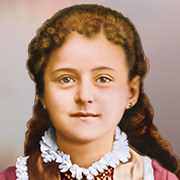0484 2425226, 9495137199 lfcongregation@gmail.com

Saint Thérèse of Lisieux (French: Sainte-Thérèse de Lisieux), born Marie Françoise-Thérèse Martin (2 January 1873 – 30 September 1897), also known as Saint Thérèse of the Child Jesus and the Holy Face, O.C.D., was a Roman Catholic French Discalced Carmelite nun who is widely venerated in modern times. She is popularly known as "The Little Flower of Jesus" or simply "The Little Flower".
Thérèse has been a highly influential model of sanctity for Catholics and for others because of the "simplicity and practicality of her approach to the spiritual life". Together with Saint Francis of Assisi, she is one of the most popular saints in the history of the church. Pope Pius X called her "the greatest saint of modern times".
Thérèse felt an early call to religious life, and overcoming various obstacles, in 1888 at the early age of 15, she became a nun and joined two of her elder sisters in the cloisteredCarmelite community of Lisieux, Normandy. After nine years as a Carmelite religious, having fulfilled various offices such as sacristan and assistant to the novice mistress, and having spent her last eighteen months in Carmel in a night of faith, she died at aged 24, following a slow and painful fight against tuberculosis.
Thérèse was beatified on 29 April 1923 and canonized on 17 May 1925, by Pope Pius XI, only 28 years after her death. By the Apostolic Letter Divini Amoris Scientia (The Science of Divine Love) of 19 October 1997, Pope John Paul II declared her a Doctor of the Church, one of only four women so named, the others being Teresa of Ávila (Saint Teresa of Jesus), Hildegard of Bingen and Catherine of Siena.
Her feast day is 1 October. Thérèse is well known throughout the world, with the Basilica of Lisieux being the second-largest place of pilgrimage in France after Lourdes.